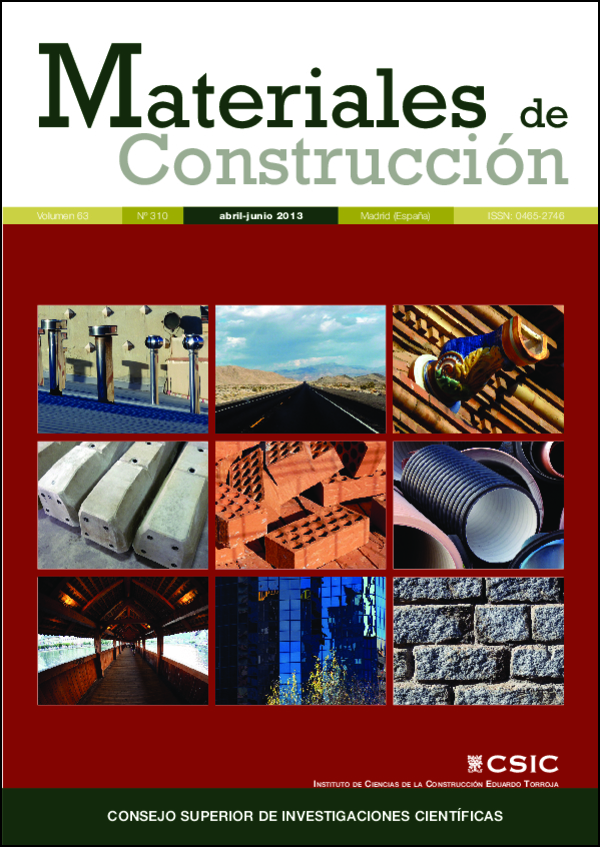A comparative study of natural zeolite and synthetic zeolite as an additive in warm asphalt mixes
DOI:
https://doi.org/10.3989/mc.2013.05911Keywords:
half-warm asphalt mixes, zeolite, environmental impact, reduction of emissionsAbstract
Zeolite can be used as an ingredient in warm bituminous mixes to reduce manufacturing temperatures. The zeolite for this purpose is usually synthetic, but natural zeolite can also be used. The research presented in this paper analyzed the use of natural zeolite from Cuba in the form of sand and filler as an additive in warm asphalt mixes and compared it to asphalt mixes with synthetic zeolite. The mixes were given the Marshall tests, and their moisture sensitivity and stiffness modulus values were also obtained. The results showed that both types of mix had a similar performance, which was only slightly lower than that of the reference mix. The use of different dosages of natural zeolite in the mixes gave the best results when the zeolite was incorporated as filler. This study demonstrated that the use of natural zeolite is an effective way of reducing the temperature of bituminous mixes.
Downloads
References
(1) Goh, S., You, Z., Van Dam, T.J.: "Laboratory Evaluation and Pavement Design for Warm Mix Asphalt". Proceedings of the 2007 Mid-Continent Transportation Research Symposium, Center for Transportation Research and Education. Iowa State University, Ames, Iowa (2007).
(2) EAPA: "Low Temperature Asphalt". Rue de Commerce 77. B-10040 Brussels. Position Paper. http://www.eapa.org/usr_img/positionpaper/low_temperature_asphalt2005 (2005).
(3) EAPA: "The use of Warm Mix Asphalt". Rue du Commerce 77, 1040 Brussels, Belgium. www.eapa.org. info@eapa.org (2009).
(4) Del Val, M. A.: "Consideraciones ambientales sobre las mezclas asfálticas. Reciclado de mezclas semicalientes". Panorama Actual de las Mezclas Bituminosas, Madrid (2005). PMCid:PMC1347501
(5) Wayne, J.P.E.: "Warm Mix Asphalt Pavements: Technology of the future?" (2004).
(6) D'Angelo, J., Jarm, E., Bartoszed, J., Baumgardner, G., Corrigan, M., Cowsert, J., Harman, T., Jamshidi, M., Wayne, J., Newcomb, D., Prowell, B., Sines, R., Yeaton, B.: "Warm-Mix Asphalt: European Practice; International Technology Scanning Program" (FHWA-PL-08-007). FHWA-HPIP, U.S. Department of Transportation. Washington, DC, USA. www.international.fhwa.dot.gov (2008).
(7) Von Devivere, M., Barthel, B., Marchand, J-P.: "Warm Asphalt Mixes by adding Aspha-min® a Synthetic Zeolite". Proceedings of the 22nd World Road Congress, PIARC. Durban, South Africa (2003).
(8) Romier, A., Audeon, M., David, J., Martineau, Y., Olard, F.: "Low Energy Asphalt with the performance of Hot-Mix Asphalt". Journal of the Transportation Research Board". No. 1962. Transportation Research Board, National Academies, Washington D.C. p. 101-112 (2004).
(9) Reyes-Ortiz. O., Pérez. F., Miró. R., Amorós. J., Gil. S. "El Proyecto Fénix en la UPC. Mezclas semicalientes". XV Congreso Ibero- Latino Americano del Asfalto. Lisboa(2009), pp. 1-10.
(10) Hurley, G., Graham, C., Prowell, B.: "Evaluation of Aspha-Min® for use in Warm Mix Asphalt". National Center for Asphalt Technology. NCAT Report 05-04. National Center for Asphalt Technologies, Auburn University (2005).
(11) Hirsch, V.: "Warm Mix Asphalt Technologies". BASt, Germany, Presentation to WMA Scan Team (2007).
(12) Harnischfeger, S.: "Aspha-min Retrospectives and Prospects". BASt, Germany, Presentation to WMA Scan Team (2007).
(13) Jones, C., West, R., Julian, G., Taylor, A., Kvasnak, A.: "Evaluation of Warm Mix Asphalt in Walla Walla, Washington". NCAT Report 11-06. National Center for Asphalt Technologies, at Auburn University (2011).
(14) Bueche, N.: "Warm Asphalt Bituminous Mixtures with regards to energy, emissions and performance". Laboratoire des Voies de Circulation (LAVOC), Ecole Polytechnique Fédérale de Lausanne (EPFL), Switzerland (2009). PMid:19687338 PMCid:PMC2754902
(15) Zaumanis, M.: "Warm Mix Asphalt Investigation". Master of Science Thesis. Technical University of Denmark. Department of Civil Engineering (2010).
(16) Ministerio de Fomento. Dirección General de Carreteras: "Pliego de Prescripciones Técnicas Generales para Obras de Carreteras y Puentes PG-3", Ediciones Liteam, Madrid (2004).
(17) Prowell, B.D.: "Warm Mix Asphalt. The International Technology Scanning Program, Sumary Report". http://international.fhwa.dot.gov/pubs/wma/summary.cfm (2007).
(18) Gutiérrez, M.: "Planta compacta potabilizadora de aguas superficiales con zeolita". Instituto Superior Politécnico José Antonio Echeverría, Cuba. www.zeocat.es/docs/aguapotabilizadora.pdf
(19) Zeolita: ¿Dónde está el mineral del siglo?, in Juventud Rebelde: Santa Clara, Villa Clara (2007).
(20) Márquez, E., Gutiérrez, M.: "Características de las zeolitas cubanas como material filtrante". Revista tecnológica del agua, vol. 135 (1995).
(21) Bascu-an, C., Soca, M.: "Zeolitas y su uso en diferentes ramas de la industria". http://www.bvsde.ops-oms.org/bvsacd/scan2/032752/032752-00.pdf (1997).
(22) Vaitkus, A., Cygas, D., Laurinavicius, A; Perveneckas, Z.: 2Analysis and evaluation of possibilities for the use of Warm Mix Asphalt in Lithuania2. The Baltic Journal of Road and Bridge Engineering., vol. 4, no. 2 (2009), pp. 80-86. http://dx.doi.org/10.3846/1822-427X.2009.4.80-86
(23) Xiao, F., Amirkhanian, S.: "Effects of liquid antistrip additives on rheology and moisture susceptibility of water bearing warm mixtures". Constr. Build. Mater., vol. 24. nº 9 (2010), pp 1649–1655. http://dx.doi.org/10.1016/j.conbuildmat.2010.02.027
(24) Hurley, G.C., Prowell, B.D., Kvasnak, A.: "Ohio field trial of Warm Mix Asphalt technologies: construction summary". NCAT Report 09-04. National Center for Asphalt Technologies, at Auburn University (2009).
Downloads
Published
How to Cite
Issue
Section
License
Copyright (c) 2013 Consejo Superior de Investigaciones Científicas (CSIC)

This work is licensed under a Creative Commons Attribution 4.0 International License.
© CSIC. Manuscripts published in both the print and online versions of this journal are the property of the Consejo Superior de Investigaciones Científicas, and quoting this source is a requirement for any partial or full reproduction.
All contents of this electronic edition, except where otherwise noted, are distributed under a Creative Commons Attribution 4.0 International (CC BY 4.0) licence. You may read the basic information and the legal text of the licence. The indication of the CC BY 4.0 licence must be expressly stated in this way when necessary.
Self-archiving in repositories, personal webpages or similar, of any version other than the final version of the work produced by the publisher, is not allowed.
















